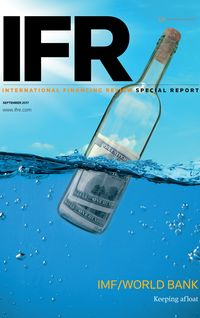Landmark deal broke new ground for lower-rated issuers and investors alike and reflects a surge in Global yen issuance by foreign corporates.
US company Corning is famous developing the glass encasement for Thomas Edison’s light bulb, Nowadays, it also produces damage-resistant glass covers for smartphones and tablets, but in August, the company had a light-bulb moment of its own, becoming the first Triple B rated company to print a yen bond in 2017.
The debut yen trade from Corning International, rated Baa1 by Moodys and BBB+ by S&P, marked its first trip to the public bond markets since 2015 and its first non-US dollar print. The deal opened up the market for similarly rated issuers to fund their Japanese operations and is part of an uptick in yen issuance by global corporates.
The speciality glass and ceramics manufacturer sold ¥21bn (US$190m) of 0.698% seven-year bonds at a 54bp spread over mid-swaps, ¥47bn of 0.992% 10-year notes at plus 74bp and ¥10bn of 1.583% 20-year paper at plus 94bp. All three tranches were priced at par. Bank of America Merrill Lynch, MUFG and SMBC Nikko were lead bookrunners.
The ¥78bn Global offering was the biggest yen deal by a BBB+ issuer but it also broke the mould in the choice of tenors, with Corning eschewing the five-year sweet spot most popular among Japanese investors and striking out along the curve, printing the first seven, 10 and 20 year tranches from a Triple B rated issuer.
Jamie Guild, executive director for UK debt capital markets origination at MUFG in London said: “We’re seeing investors in Japan following what the international community has been doing for the last few years and pushing further along the curve to try and get some return. The natural investor base for Triple B credits is usually around five years. The Corning deal showed they are happy to look at extending duration.”
The Corning deal reflected a shift in the risk appetite of Japanese investors, which traditionally target higher-rated, well-known names.
“Single A has always been in the swing zone for Japanese life insurers and specialised banks. The Corning trade suggests they are broadening their net and reaching down the credit rating spectrum,” said Steve Apted, head of debt syndicate at SMBC Nikko Capital Markets.
With 10-year Japanese government bonds close to zero at a time when US rates are rising, investing in lower-rated paper provides Japanese investors with much-needed yield.
Corning first entered the Japanese market in 1977. In 2016, the country accounted roughly 5% of its total net sales.
Issuers with yen income streams or assets face a choice of either employing a short-term hedge using foreign exchange, or swapping from dollars and euros. Going straight to the yen market removes the need for derivatives and bankers said the all-in cost of funding was relatively attractive relative to dollars and will provide other Triple B rated corporates looking to fund yen operations an attractive alternative to traditional bank loans or swapping dollar-denominated debt.
“Cross-currency swap charges for corporates have risen considerably since the financial crisis. A plain vanilla deal such as this provides a much cleaner and simpler way for corporates to fund their yen liabilities,” said Apted.
With Corning only ever having previously funded in dollars before, pricing in yen also gave the company currency diversification.
The yen-dollar basis swap has tightened by around 40bp since the middle of 2015, Guild noted, saying: “We’ve seen a big improvement in the basis cost to swap out of yen but it’s still a relatively high cost to pay for corporates that trade at a tight dollar Libor spread.”
Given the relatively high cost of swapping, the yen market is most appealing for companies with Japanese operations.
“I think for the first time in a while we are seeing Japan being utilised more actively as a diversification play for the institutional bid for some of the major issuers,” said Guild.
Quick fix
Corning was the third US corporate to hit the market, after deals from higher-rated Starbucks, which also made its Global yen debut, and Walmart, which is a more frequent issuer.
US retail giant Walmart, rated Aa2/AA, raised ¥170bn at maturities of five, seven and 10 years in July in a Global yen format. The company has an existing Samurai programme and had used that for its previous three trades, but opted for the Global format that gave it a quicker route to market rather than the more onerous documentation associated with a Samurai trade. The US retail giant generated an order book of around ¥200bn as investors, who had been starved of yen-denominated US corporate supply last year, piled in.
There are a lot of Japanese investors that are not going to buy these corporates in US dollars or euros, for example, so the way to access them is through the yen market,” said Guild.
The flurry of US issuance came after an absence of US supply in the yen market last year, following trades from Apple and Proctor & Gamble in 2015.
Like Corning, Starbucks, rated A2/A, made its yen debut, when it came to the market in March with a ¥85bn of seven-year sustainable bonds, marking a further step in the evolution of the country’s Green bond market. The Japan International Cooperation Agency issued social responsibility bonds in September, while Japan’s Government Pension Investment Fund has announced plans to boost Environmental, Social And Governance (ESG) investment.
Japan is not recognised as Europe in having a developed ESG market but Guild said that the sustainable aspect of the Starbucks trade transaction proved to be a pretty big draw, particularly for some of the insurance companies in Japan. Proceeds of the Starbucks deal were used to purchase coffee beans grown via environmentally friendly methods and to support coffee farmers in Africa and elsewhere.
Starbucks followed in the footsteps of Electricite de France, the French utilities giant and bond market stalwart, which printed the first Green bond in Samurai history on January 20. EDF returned to Japan for the first time since 2009, raising ¥137bn in a four-part offering of bonds with maturities of 10, 12, 15 and 20 years, the latter being the longest ever maturity in a Samurai format.
“EDF is a well-recognised name in Japan and offered some spread versus other foreign names,” said one source close to the deal.
Mitsubishi UFJ Morgan Stanley, Mizuho and SMBC Nikko were lead managers.
As Japanese investors look for greater yield and variety, the yen market is also proving to be a popular destination for European banks raising money to meet new Total Loss-Absorbing Capital requirements. French banks have been regular issuers and have led the charge in the Samurai format, with Societe Generale coming to the market in May with a trade that was capped at ¥80bn.
“French banks in particular have done a lot of work in explaining their TLAC story to Japanese investors,” said one syndicate source.
In June, Credit Agricole raised ¥203.9bn in the biggest offering of Samurai bonds on record from a European bank. The five-tranche issue, split between preferred and non-preferred senior notes, is also the fifth largest in the history of the Samurai market.
BPCE printed the first retail sale of senior non-preferred Samurai bonds on July 7, just a week after the lender sold ¥58.1bn of senior preferred bonds to institutional investors at maturities of five, seven, 10 and 15 years.
Guild said: “It’s inevitable that more banks will look to Japan to fund TLAC needs because the yen market is still a great source of diversification. While the yen funds may have half an eye on the international market, they are really focused on yen-denominated alternatives, and therefore there is limited contamination into the international markets. The investor base for TLAC bonds in Japan has also been growing.”
Foreign banks have been generally more active than corporates in the Samurai market because they are more frequent issuers per se, with many having well-established programmes.
“Starting a Samurai programme can be quite onerous in terms of documentation,” said one senior syndicate source. “Japanese investors have a preference for the Samurai format over a Global yen programme, and because financials have so much issuance to do, then it is worth their while going through the process to establish a Samurai programme.”
The yen market will not suit the corporate finance needs of every treasury department, and particularly not those with no operations to fund. But the recent flurry of Global yen issuance by foreign corporates could encourage other names to diversify, especially if political volatility continues to spill over into international capital markets.
The Japanese market tends to be more stable than US and European market when reacting to event risk.
“In the past when we’ve seen fairly volatile international markets, Japan has provided a reasonably solid, stable, alternative source of funds,” said Anthony Barklam head of DCM at MUFG.
“We’re encouraging those that have an interest in diversifying away from the US and Europe to take advantage of the current resurgent bid from the Japanese domestic investor base and place down a marker.”
To see the digital version of this report, please click here.
To purchase printed copies or a PDF of this report, please email gloria.balbastro@tr.com



